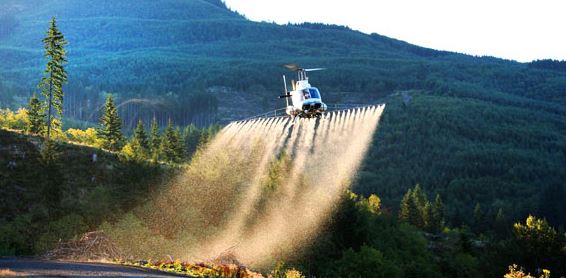Forest Pesticide Applications

Forest pesticide applications can be a useful tool for forest landowners to effectively manage their forestland. The Washington State Forest Practices Act, which regulates the application of pesticides on forestland, provides a basis for landowners and government agencies to work together to protect water quality and public health and safety.
The Forest Practices Act places specific requirements on pesticide applicators, including establishing buffers between the area to be treated and nearby streams, surface water intakes, agricultural lands, residences and sensitive sites.
‘Pesticide’ is a broad term that includes insecticides and the herbicides that forest landowners may use. Forest landowners use primarily herbicides. Because fast-growing brush, weeds, and invasive plants compete with young trees for nutrients, sunlight and water, forest landowners may choose to use herbicides to improve the survival of newly planted tree seedlings after timber harvests or other activities. Herbicides are typically applied to forestlands only once or twice in the 40-to-65-year life span of a managed stand of timber in Washington state.
The Forest Practices Act places specific requirements on pesticide applicators, including establishing buffers between the area to be treated and nearby streams, surface water intakes, agricultural lands, residences and sensitive sites.
‘Pesticide’ is a broad term that includes insecticides and the herbicides that forest landowners may use. Forest landowners use primarily herbicides. Because fast-growing brush, weeds, and invasive plants compete with young trees for nutrients, sunlight and water, forest landowners may choose to use herbicides to improve the survival of newly planted tree seedlings after timber harvests or other activities. Herbicides are typically applied to forestlands only once or twice in the 40-to-65-year life span of a managed stand of timber in Washington state.
Regulation
While the Forest Practices Act regulates pesticides application on forestland, the chemicals themselves are regulated by the US Environmental Protection Agency (EPA) and the Washington State Department of Agriculture (WSDA).
In Washington state, pesticide applicators are licensed and regulated by WSDA. Applicators are required to precisely follow the information and instructions included on the pesticide’s label. The pesticide label will describe what crops the pesticide can be used on, maximum rate allowed, recommended rates by crop, what it should be used for and under what conditions it can be safely and legally applied. The pesticide label will also state any restrictions on the pesticides use. Spray application records are maintained according to WSDA rules (WAC 16-228-1320) for seven years.
|
|
Minimum Buffer
Favorable (<7 mph) |
Maximum Buffer
Calm or Unfavorable |
|---|---|---|
|
Fish bearing waters
|
60-150 ft.
(width of inner zone) |
325 ft.
|
|
Flowing non fish bearing waters
|
50 ft.
|
100 ft.
|
|
A Wetland
|
50 ft.
|
325 ft.
|
|
B Wetland
|
25 ft.
|
325 ft.
|
|
Houses
|
200 ft.
|
|
|
Agricultural lands
|
100 ft.
|
|
Permitting
Most aerial chemical applications on forestland in Washington state require a Forest Practices Application/Notification (FPA/N) issued by Washington State Department of Natural Resources (DNR).
Instructions for filling out the Aerial Chemical FPA/N and a description of the information DNR uses in screening proposals are available here.
More information on how DNR screens FPA/Ns can be found in WAC 222-16-070.
Many herbicides are sold under a variety of brand names. The permit may list many different names, but typically only one of each active ingredient is applied at a time. Permittees list several brands because price and availability of products change. The permit is valid for three (3) years from the date it is approved.
Notification
State rules for aerial chemical applications on forestland require landowners to post notices of the spraying at least 5 days before the spraying begins and for 15 days after spraying is completed. Landowners also must post notices at any signed trailheads adjacent to the locations being treated.

DNR strongly encourages landowners to contact neighbors before an aerial spray operation begins. Landowners who are interested in receiving advance notice of aerial spraying in their area are encouraged to enroll in the Forest Practices Application Review System (FPARS).
Find information on how to receive advance notice of aerial spraying in your area.
Compliance
If you suspect an aerial application may be out of compliance with the law, report it to the Washington State Department of Agriculture's
Pesticide Management Division: (877) 301-4555.
To learn more about compliance:

